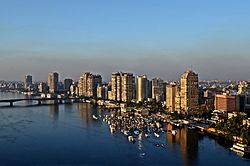Prior to 19th century
| History of Egypt |
|---|
 |

- 1st C. BCE – Babylon Fortress built (approximate date).
- 33 CE – Origins of the Coptic Orthodox Church. [1]
- 4th–5th C. CE – Saints Sergius and Bacchus Church (Abu Serga) built.
- 6th C. – Church of Saint Menas established.
- 642 – Mosque of Amr ibn al-As built.
- 873 – Ahmad ibn Tulun founds El-Katai. [1]
- 879
- Mosque of Ibn Tulun built. [1]
- Church of St. George built (approximate date).
- Church of the Virgin Mary (Haret Zuweila) built (approximate date).
- 970
- Misr al-Qahira settlement founded by Fatimid Al-Mu'izz li-Din Allah. [2] [1]
- Al-Azhar University established.
- 972 – Al-Azhar Mosque established.
- 978 –The Hanging Church rebuilt (approximate date).
- 979 – Saint Mercurius Church in Coptic Cairo rebuilt (approximate date).
- 992 – Al-Hakim Mosque built.
- 11th C. – Church of the Holy Virgin (Babylon El-Darag) built.
- 1016 – Lulua Mosque built.
- 1073 – Saint Barbara Church in Coptic Cairo restored.
- 1085 – Juyushi Mosque built.
- 1092 – City wall and Gates of Cairo built (including Bab Zuweila and Bab al-Nasr).
- 1125 – Aqmar Mosque built.
- 1154 – Al-Hussein Mosque built.
- 1160 – Al-Salih Tala'i Mosque built.
- 1168 – Egypt's capital moved from Fustat to Cairo.
- 1176 – Cairo was unsuccessfully attacked in the Crusades. [1]
- 1183 – Saladin Citadel built.
- ca.1205 – Harat el-Yahoud Synagogue rebuilt and Maimonides works there; it is rebuilt in the 19th century as the Maimonides Synagogue [3]
- 1250 – City becomes capital of Mamluk Sultanate.
- 1280 – Qalawun complex built (approximate date).
- 1318 – Al-Nasir Muhammad Mosque built.
- 1340 – Mosque of Amir al-Maridani established.
- 1347 – Aqsunqur Mosque built.
- 1349 – Mosque of Shaykhu built.
- 1352 – Amir Taz Palace built.
- 1355 – Khanqah of Shaykhu built.
- 1359 – Mosque-Madrassa of Sultan Hassan built.

- 1421 – Mosque of Sultan al-Muayyad built.
- 1517
- January: Battle of Ridaniya occurs near Cairo. [4]
- Capture of Cairo by Ottoman forces. [1]
- City becomes provincial capital during Selim I's rule of Ottoman Empire.
- 1774 – Mosque of Abu Dahab built.
- 1788 – Al Musafir Khana Palace built.
- 1798 – Napoleon arrives. [1]
- 1800 – Population: 200,000 (approximate figure). [1]








